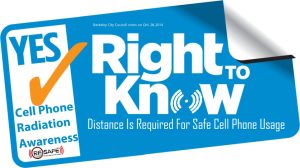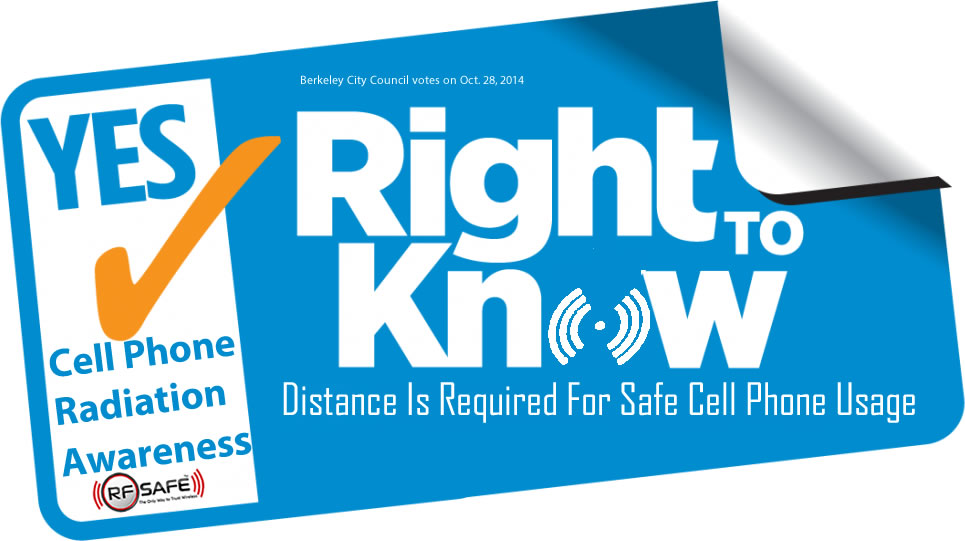 UPDATE: Cell phone Radiation Right-To-Know Ordinance Unanimously Passes In Berkeley CA May 13, 2015
UPDATE: Cell phone Radiation Right-To-Know Ordinance Unanimously Passes In Berkeley CA May 13, 2015
Office of Councilmember Max Anderson, District 3
CONSENT CALENDAR October 28, 2014
To: Honorable Mayor and Members of City Council
From: Councilmember Max Anderson, Councilmember Kriss Worthington
Subject: City Manager Referral: Cell phone ordinance referral to City Manager
RECOMMENDATION:
Refer to City Manager for the creation of an ordinance to have cell phone retailers give to consumers who purchase a phone, a factual, informational handout referring the user to their cell phone manufacturers’ disclosure regarding the recommended separation distance for use against the body.
ProPOSED WORDING:
“The Federal Government requires that cell phones meet radio frequency (RF) exposure guidelines. Don’t carry or use your phone in a pants or shirt pocket or tucked into a bra when the phone is turned ON and connected to a wireless network. This will prevent exposure to RF levels that may exceed the federal guidelines.
Refer to the instructions in your phone or user manual for the recommended separation distance.”
The above advisory will appear in the form of an informational handout to be handed to consumers by the retailer at the time of purchasing a cell phone.
NOTE – City staff to provide specific font size and design of the handout as well as text about this being a requirement of the City of Berkeley with the city’s official seal. By adopting this proposal, the City of Berkeley will ensure that consumers are made aware of the Federal Communications Commission (FCC)’s required disclosure to never carry or use a cell phone directly against the body (i.e., in a pocket or tucked into a bra) when turned ON and connected to a wireless network in order to avoid exposure to radio frequency (RF) energy that may exceed the federal exposure guideline.
FINANCIAL IMPLICATIONS:
World renowned attorney, Harvard Law Professor and Director of Edmund J. Safra Center for Ethics, Lawrence Lessig, has offered to provide legal advice to the City of Berkeley as well as to defend this proposed ordinance pro bono.
BACKGROUND:
Essential to understanding the intent of this recommendation is the fact that what is proposed is not a new consumer disclosure, but rather an attempt to further the effectiveness of cell phone manufacturers’ existing consumer disclosures. The problem with the current manner in which this information is disclosed is that it is written in “legalese” and located in the fine print of user manuals or hidden within screens on the phone itself where it is unlikely to be seen by the typical consumer.
The nature of the disclosure itself is to direct consumers to never wear or use a cell phone directly against the body (as in a pants or shirt pocket or tucked into a bra or waistband) when turned ON and connected to a wireless network.
Doing so, the consumer risks exposure to radiofrequency (RF) radiation that may exceed the federal exposure guideline established by the Federal Communications Commission (FCC).
Why are the “fine print” separation distance advisories located within phones and user manuals?
FCC rules state that cell phones must be tested for compliance with exposure guidelines – but, they allow the phones to be tested held a small “separation distance” away from the torso simulating being carried or used in a belt clip or holster.
The testing protocol for “body-worn” use was established prior to 1996 when phones were assumed to be carried on the body in a holster or belt clip and when they were not designed to be worn and/or used in pockets or tucked into bras, typical ways that phones are used today.
Because the 18 year old federal guidelines have not been updated since they were originally established in 1996, the FCC still assumes that all cell phones are only carried or used on the body in a holster or belt clip. Manufacturers (wrongfully) assert that all their customers always use a holster or belt clip to maintain the required separation distance when carried or used on the body.
The FCC does not test cell phones the way they are typically used in a pocket directly against the body.
Therefore, if a cell phone is used in a pocket or tucked into a bra or waistband, the consumer may be exposed to RF radiation levels that exceed the federal exposure guideline.
In July, 2012, the Government Accountability Office (GAO) issued a report called Exposure and Testing Requirements for Mobile Phones Should Be Reassessed in which the following statements appear:
“FCC has also not reassessed its testing requirements to ensure that they identify the maximum RF energy exposure a user could experience. Some consumers may use mobile phones against the body, which FCC does not currently test, and could result in RF energy exposure higher than the FCC limit. ” … “FCC should formally reassess and, if appropriate, change its current RF energy exposure limit and mobile phone testing requirements related to likely usage configurations, particularly when phones are held against the body. “
Because of the separation distance allowed during testing against the body (torso), the FCC requires that manufacturers must inform consumers to always maintain this separation distance used at testing to ensure that the exposure levels remain below the “as tested” levels:
“Specific information must be included in the operating manuals to enable users to select body-worn accessories that meet the minimum test separation distance requirements.
Users must be fully informed of the operating requirements and restrictions, to the extent that the typical user can easily understand the information, to acquire the required body-worn accessories to maintain compliance. Instructions on how to place and orient a device in body-worn accessories, in accordance with the test results, should also be included in the user instructions.
All supported body-worn accessory operating configurations must be clearly disclosed to users through conspicuous instructions in the user guide and user manual to ensure unsupported operations are avoided.”
[FCC KDB 447498 DOl General RF Exposure Guidance– Section 4.2.2(4)]
The above FCC guideline is the basis for the advisories that appear in the fine print of every cell phone user manual.
In spite of the FCC requiring that consumers be made aware of this information, manufacturers print this necessary separation distance advisor in fine print “legalese” and locate the consumer disclosure in difficult to find sections of cell phone user manuals or buried within the text on the phone itself.
NOTE: This proposed ordinance seeks to make consumers aware of their cell phone manufactures’ “separation distance” disclosure as required by the FCC. It also reiterates in consumer-friendly language the manufacturers’ message that consumers must never use or carry a cell phone directly against the body (while turned ON and connected to a wireless network).
Examples of “fine print” separation distance advisories for popular cell phones: Apple iPhone 5- Found on the Apple website at: https://www.apple.com/legal/rfexposure/iphone5,1/e/
And, can be found on the iPhone navigating through the following screens: Settings>General> About> Legal> RF Exposure
“To reduce exposure to RF energy, use a hands-free option, such as the built-in speakerphone, the supplied headphones or other similar accessories. Carry iPhone at least 10mm away from your body to ensure exposure levels remain at or below the as-tested levels. ”
Samsung Galaxy S5 – Refer to “Health & Safety & Warranty Guide” (pg 3)
Also found on the phone navigating through the following screens: Settings>About Device>Legal Information>Samsung Legal>Health & Safety
“For body-worn operation, this phone has been tested and meets FCC RF exposure guidelines when used with an accessory that contains no metal and that positions the mobile device a minimum of 1.0 cm from the body.”
BlackBerry Bold – Found in user guide “Safety and Product Information”- “Use hands-free operation if it is available and keep the BlackBerry device at least 0.59 in (15mm) from your body (including the abdomen of pregnant women and the lower abdomen of teenagers) when the BlackBerry device is turned on and connected to a wireless network.”
Motorola Moto X – Found in user guide in the section titled “Safety, Regulatory & Legal” (pg 64)
“When using the mobile phone next to your body (other than in your hand or against your head), maintain a distance of 1.5 cm (3/4 inch) from your body to be consistent with how the mobile phone is tested for compliance with RF exposure requirements.”
Why should we be concerned about consumers not seeing the manufacturers’ “fine print” advisories to keep their cell phone a small distance from the body?
The manufacturers’ separation distance consumer advisories hidden in the manuals range from requiring a minimum usage distance of from 5 mm (1/5 inch) to 25 mm (l inch) away from the torso. They seem like such small distances – why should consumers be informed?
Because, as a matter of physics, the microwave emissions from cell phones decrease sharply as the distance is increased. Even a 5 mm separation distance makes a significant difference in reducing the exposure levels consumers will receive when the phone is used or carried directly against the body.
Consumers have the right to know!
How is this proposed legislation different from what San Francisco adopted in 2011?
On September 10,2012, the 9th Circuit Court of Appeals ruled in an unpublished decision that the Cell Phone Fact Sheet the city had required to be distributed at the point of sale went beyond facts as it also contained recommendations from the city that do not appear in the user manuals as to what consumers should do if they want to reduce exposure to radiofrequency energy emissions (such as to “turn off the phone when not in use”).
Because the Court saw this situation as mandating controversial statements that were not purely factual, they ruled that the city’s law violated industry’s 1st Amendment Constitutional rights.
Berkeley’s proposed Cell Phone Right to Know ordinance seeks to inform consumers of the “body-worn separation distance” disclosure and directs consumers to their particular phone manufacturers’ required “separation distance” as this crucial safety information is not visible in the packaging. The FCC requires that consumers be made aware of these “body-worn separation distance” disclosures – so, this action is clearly in alignment with requirements already promulgated by the federal regulatory agency that oversees cell phone radiation exposure guidelines.
What are the facts about San Francisco’s settlement of their Cell Phone Right to Know Law?
From the San Francisco Department of Environment website: “San Francisco believes the Ninth Circuit’s opinion is deeply flawed, but the City is bound by that opinion, as the district court would be in further litigation over San Francisco’s ordinance. Accordingly, San Francisco settled the case with CTIA in exchange for a waiver of attorneys’ fees.
However, because the Ninth Circuit’s decision is unpublished, it is not binding on any jurisdiction other than San Francisco, and it would not be binding on any other district court in litigation over any legislation from another jurisdiction imposing disclosure requirements on retailers.
Furthermore, under the Federal Rules of Appellate Procedure, no party is permitted to cite the Ninth Circuit’s unpublished opinion as precedent in future litigation.”
The CTIA dropped their suit (upon San Francisco’s repeal of the law) prior to the court ruling on their petition for reimbursement of $112,097 in attorney fees.
For more information, please read these relevant news articles: http://www.newsweek.com/iphone-6-bendgate-apple-says-your-iphone-shouldnt-go-your – pocket-avoid-radiation-273313 – “Apple’s Instructions Say Not to Keep Your Phone in Your Pocket Anyway”
http://content.time.com/time/magazine/article/0,9171,2029493,00.html -“Cell-Phone Safety: What the FCC Didn’t Test”
CONTACT:Berkeley City Council Max Anderson
Official 2014-10-28 Item 14 City Manager Referral Cell Phone








